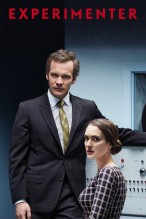Overview
Yale University, 1961. Stanley Milgram designs a psychology experiment that still resonates to this day, in which people think they’re delivering painful electric shocks to an affable stranger strapped into a chair in another room. Despite his pleads for mercy, the majority of subjects don’t stop the experiment, administering what they think is a near-fatal electric shock, simply because they’ve been told to do so. With Nazi Adolf Eichmann’s trial airing in living rooms across America, Milgram strikes a nerve in popular culture and the scientific community with his exploration into people’s tendency to comply with authority. Celebrated in some circles, he is also accused of being a deceptive, manipulative monster, but his wife Sasha stands by him through it all.
Even if not by name, most people will have heard of the experiments this movie is about. Stanley Milgram designed his so-called ‘obedience studies’ in the early 1960s at Yale, driven by his Jewish background trying to understand the behaviours in the Holocaust at a time when Adolf Eichman was on public trial for his Nazi crimes. Milgram was trying to understand how people respond to (perceived) authority and rules when they are given instructions that most people in ‘normal’ circumstances would generally be thought to obviously decline to carry out.
The experiment itself is well-known: two strangers are asked to participate in the experiment of their own free will, one as ‘teacher’, the other as ‘learner’. The learner has to answer a series of questions until they get all the answers correct. If the learner answers incorrectly, the teacher has to administer an electric shock to the learner. For the first mistake the shock is 45 Volt, and for every further mistake this voltage increases in 30 small steps to a maximum of 450 Volt.
Milgram ran the experiment literally hundreds of times, and found that the majority of ‘teachers’ would, reluctantly, continue the experiment all the way up to inflicting 450 volts to the ‘leaner’, despite the learner crying out in pain by step 10 already and begging to be released and stop the experiment. Note that the learner was actually part of the research team and never received any real shocks. Over time, Milgram changed the set-up of the experiment but the results remained the same.
I won’t go into the details of the psychology of the experiment here, but it will be clear that it has had lasting impact on how we think about people’s purported understanding of free will vs compliance. And that is what makes the movie interesting to watch; even if you know the experiment it remains fascinating and intriguing to ponder and wonder if it would be any different in our day and age or in specific cultures.
But back to the movie itself. Whilst the subject is fascinating, the movie itself is less strong unfortunately. The best scenes are those about the experiments themselves; the further away we get from the experiments, the weaker the movie becomes.
The director (Michael Almereyda) uses various ‘tricks’ to try to be creative in how to present the story, but they don’t all work. Peter Sarsgaard is solid in his role as Milgram, and he speaks directly to the camera and audience explaining things along the way, which feels fine. In various scenes away from the experiments the movies uses rear-projected backgrounds, presumably to create an abstract feeling about the situation at hand, but it feels forced and just using a normal set would have been better. And even less subtle is a scene where Milgram talks to the camera about the hard-to-swallow implications of his findings, and to illustrate the fact that for many scholars there is an elephant in the room that they don’t really want to talk about, the director actually put… an elephant in the room behind Milgram.
I really enjoyed the first hour or so, even with some of the unnecessary directorial trickery; unfortunately the movie wanders a bit the last half hour and loses the viewer’s interest. The interactions between Milgram and others outside the experiment are weak and mostly lack emotion. Even the relationship with his wife (a bland Winona Ryder) feels passionless in their courtship days and we don’t know enough to understand why it seems to be falling apart towards the end of the movie.
It is still worth watching for the experiments and hypothesising on what that could imply about human nature and behaviour. As a cinema experience, it is however not that great at all unfortunately.
6/10 for the still intriguing and relevant subject matter.











